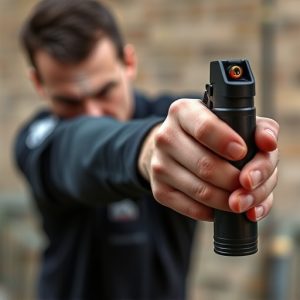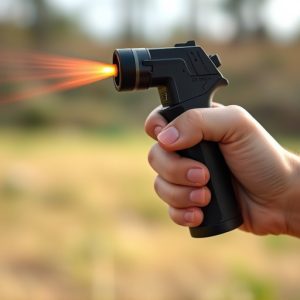Pepper Spray: Legal Carry Guide & Protection Device Effectiveness
Pepper spray, a non-lethal self-defense tool, offers temporary blindness and breathing difficulties…….
Pepper spray, a non-lethal self-defense tool, offers temporary blindness and breathing difficulties to escape dangerous situations. Legal acquisition requires understanding local regulations on age restrictions, permits, storage, and use cases, varying globally. Different formulations and application methods exist, with crucial compliance to avoid legal issues and ensure personal safety. Responsible handling involves proper storage, bystander safety, and regular training for optimal deterrence in self-defense scenarios.
“Personal protection devices, like pepper spray, have gained prominence as effective self-defense mechanisms. This article delves into the world of chemical irritants, exploring their role in personal safety equipment. We’ll navigate legal frameworks surrounding the carriage of pepper spray, providing a comprehensive overview for those seeking to protect themselves.
From understanding the chemistry behind its effectiveness to real-world applications, this guide covers everything you need to know about pepper spray, including best practices for safe and responsible use, with a focus on how to legally carry pepper spray.”
- Understanding Chemical Irritants and Their Role in Personal Protection Devices
- Legal Frameworks for Carrying Pepper Spray: A Comprehensive Overview
- Types of Pepper Spray and Their Effectiveness
- Safety Measures and Responsible Use of Pepper Spray
- Real-World Applications and Success Stories of Pepper Spray as a Self-Defense Mechanism
Understanding Chemical Irritants and Their Role in Personal Protection Devices
Chemical irritants play a crucial role in personal protection devices, offering a non-lethal means of deterring potential threats. These substances, often referred to as pepper spray, create a temporary yet intense sensory disruption, enabling users to gain time and distance from dangerous situations. The active ingredients in chemical irritants are carefully formulated to cause irritation without significant harm, making them legal for personal use in many jurisdictions when carried according to local regulations.
Understanding the mechanics behind these irritants is essential. When deployed, pepper spray creates a fog or gel that reaches the eyes and respiratory system, leading to temporary blindness, coughing, and difficulty breathing. This disorientation provides an opportunity for individuals to escape potentially dangerous encounters. Knowing how to legally carry pepper spray is vital; it requires adhering to specific rules regarding age restrictions, permit requirements, and storage guidelines, ensuring its responsible use for personal safety.
Legal Frameworks for Carrying Pepper Spray: A Comprehensive Overview
The legal frameworks surrounding the carrying of pepper spray vary significantly from one jurisdiction to another, with regulations often being tied to a region’s specific laws on self-defense and public safety. Understanding how to legally carry pepper spray is crucial for those looking to protect themselves in potentially hazardous situations. In many countries, pepper spray is classified as a weapon or a controlled substance, necessitating permits or licenses for acquisition and possession. Some regions permit its use only for law enforcement agencies, while others allow civilians to own and carry it under specific conditions.
For individuals seeking to know how to legally carry pepper spray, it’s essential to research and comply with local laws. This typically involves background checks, training requirements, and age restrictions. Certain areas might differentiate between personal use and self-defense, with different regulations for each category. Additionally, some jurisdictions have specific guidelines on the type and amount of capsaicin (the active ingredient in pepper spray) permitted, as well as the packaging and labeling standards to ensure safety and legality. Staying informed about these legal frameworks is vital to avoid any potential legal repercussions while ensuring personal protection.
Types of Pepper Spray and Their Effectiveness
Pepper spray, a common chemical irritant used for personal protection, comes in various types, each with distinct features and levels of effectiveness. The most prevalent forms include aerosol cans, typically dispensed through a trigger mechanism, and gel or foam formulations designed for easier application at close range. Aerosol sprays offer wide-area coverage, making them ideal for rapid defense against multiple attackers. Gel and foam varieties, while offering reduced spray distance, are known for their high concentration of capsaicin, the active ingredient responsible for the burning sensation and temporary incapacitation.
Understanding local laws regarding how to legally carry pepper spray is essential before considering it as a personal protection device. Different jurisdictions have varying restrictions on where and when you can possess and use pepper spray. Familiarize yourself with your area’s regulations to ensure compliance and mitigate potential legal repercussions.
Safety Measures and Responsible Use of Pepper Spray
The responsible use and safety measures surrounding pepper spray are paramount for its effective deployment as a personal protection device. It’s crucial to understand that pepper spray is a powerful irritant designed to temporarily disable an assailant, providing a critical window of escape or time to seek help. When carried legally, it becomes a vital tool in self-defense scenarios.
To legally carry pepper spray, individuals must familiarize themselves with local and state regulations. This includes understanding the permitted amounts, storage requirements, and any restrictions on where it can be used or displayed. Proper handling involves keeping it sealed and out of reach of children, and knowing how to deploy it effectively without endangering bystanders. Regular training in its use is essential to ensure its potency remains a deterrent and not a cause for harm.
Real-World Applications and Success Stories of Pepper Spray as a Self-Defense Mechanism
Pepper spray, a chemical irritant designed to temporarily incapacitate an aggressor, has become an indispensable personal protection device for individuals worldwide. Its real-world applications are vast and diverse, ranging from law enforcement to civilian self-defense. One of the key advantages of pepper spray is its legality in many countries, provided users obtain the necessary permits and follow local regulations on how to legally carry pepper spray.
Success stories abound, with individuals using pepper spray to deter and escape potential attackers. For example, in situations where a person feels threatened while walking alone at night or in isolated areas, a swift deployment of pepper spray can provide crucial time for escape and safe arrival at a secure location. These devices have proven effective in neutralizing assailants without causing permanent harm, thereby enhancing personal safety and security.
Pepper spray, as a chemical irritant for personal protection, has proven its effectiveness in numerous real-world applications. Understanding its role, navigating legal frameworks for carrying pepper spray, and adopting safety measures are essential steps towards responsible use. By recognizing the diverse types of pepper spray available and their varying levels of effectiveness, individuals can make informed decisions to protect themselves. Ultimately, how to legally carry pepper spray is a crucial consideration that, when combined with proper training and awareness, can empower folks to defend themselves in potentially dangerous situations.

